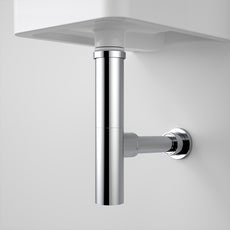The Essential Guide to Bathroom Wastes: Combining Practicality and Design
When planning a bathroom renovation, even the smallest details shape the final result. Wastes might not be the first thing you consider, but they’re integral to how your space functions and looks. At The Blue Space, we focus on delivering products that balance reliability with aesthetics. Our range spans basin wastes to shower grates, each designed to elevate your bathroom’s efficiency without sacrificing style. Let’s break down how these components can make a difference.
Why Bathroom Wastes Matter
Wastes are the backbone of effective drainage. They manage water flow, reduce blockages, and maintain hygiene. But they’re more than just functional—they’re part of your bathroom’s design language. A poorly chosen waste can disrupt a sleek aesthetic, while the right one enhances it. Whether you’re renovating a powder room or a family bathroom, selecting the correct waste system is a decision that impacts daily life.
Basin Wastes: Small Parts, Big Impact
Basin wastes are tailored to sink designs, offering both practicality and visual harmony. The three main types cater to different needs:
-
Pop-Up basin wastes use a lever mechanism for effortless operation. They’re ideal for modern bathrooms where simplicity is key.
-
Pop-down versions sit flush with the basin for a minimalist look. Perfect for those who dislike visible hardware.
-
Overflow-compatible wastes prevent water damage by redirecting excess water. A must for deeper basins or family homes.
Pair these with our bathroom basins for a cohesive setup. Brands like Caroma and Fienza provide durable, stylish choices.
Bath Wastes: Where Safety Meets Style
Bath wastes handle significant water volume, making durability non-negotiable. The right choice depends on your bath’s design and how you use it:
-
Pop-up mechanisms are user-friendly, ideal for busy households.
-
Pop-down designs offer a seamless finish, suiting contemporary freestanding tubs.
-
Overflows-integrated systems add peace of mind, especially in deeper baths used by children.
Our bath wastes collection known for their robust construction.
Sink Wastes: Built for Demanding Spaces
Kitchen and laundry sinks endure heavy use, so their wastes need to withstand constant wear. Key features to consider:
-
Stainless steel or brass construction resists corrosion.
-
Removable strainers simplify cleaning.
-
Bottle traps prevent odours and leaks.
Match your sink wastes with our kitchen sinks and pair them with bottle traps designed for Australian plumbing standards. Brands like ADP and Meir offer heavy-duty solutions.
Shower Channels & Grates: Modern Drainage Solutions
Shower drainage has evolved beyond basic grates. Linear channels and anti-slip designs now dominate modern bathrooms:
-
Linear channels create a discreet, streamlined look.
-
Anti-slip grates improve safety in wet areas.
-
Stainless steel or coated aluminium resists rust and soap buildup.
Explore our shower channel & grates to complement our showers range. For a cohesive design, pair with accessories from Indigo.
Floor Wastes: Protecting Your Home
Floor wastes are essential in wet rooms, laundries, and bathrooms prone to splashes. They prevent water pooling and protect subfloor structures. Look for:
-
Grated tops to catch debris.
-
Odour seals to maintain freshness.
-
Adjustable height for compatibility with floor finishes.
Our floor wastes work seamlessly with tiles, stone, or concrete. For full waterproofing systems, consider pairing with products from Turner Hastings.
What Sets The Blue Space Apart
-
Depth of Knowledge: With over a decade in the industry, we understand Australian homes. Our team provides clear, personalised advice.
-
Quality Focus: Every product meets stringent performance benchmarks.
-
Innovative Range: From pop-down bath wastes to designer grates, we stock forward-thinking designs.
-
Trusted Partnerships: Brands like Phoenix and Nero align with our commitment to excellence.
Design Integration Tips
Wastes should complement your fixtures. For example:
-
Brushed nickel finishes pair with vintage tapware.
- Bronze brings depth, resilience, and soul.
-
Matte black suits modern, industrial themes.
- White offers classic clean look.
-
Chrome offers a timeless, versatile look.
-
Gunmetal adds a touch of sophistication and style.
-
Champagne a soft, sunlit gold that wraps your space in warmth.
Browse our bathroom accessories for cohesive styling.
Installation Insights
Proper installation prevents leaks and extends product life:
-
Always check waste-basin compatibility.
-
Use silicone sealant for watertight connections.
-
Consult a licensed plumber for complex setups.
Final Considerations
Choosing bathroom wastes isn’t just about function—it’s an investment in your home’s longevity and style. At The Blue Space, we’re here to help you navigate options with confidence. Explore our collections, or reach out for tailored advice. Let’s build a bathroom that works as hard as you do.














